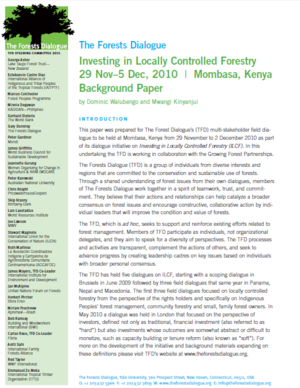Background Paper: Investing in Locally Controlled Forestry - Kenya
This paper was prepared for The Forest Dialogue’s (TFD) multi-stakeholder field dialogue to be held at Mombasa, Kenya from 29 November to 2 December 2010 as part of its dialogue initiative on Investing in Locally Controlled Forestry (ILCF). In this undertaking the TFD is working in collaboration with the Growing Forest Partnerships.
The TFD has held five dialogues on ILCF, starting with a scoping dialogue in Brussels in June 2009 followed by three field dialogues that same year in Panama, Nepal and Macedonia. The first three field dialogues focused on locally controlled forestry from the perspective of the rights holders and specifically on Indigenous Peoples’ forest management, community forestry and small, family forest owners. In May 2010 a dialogue was held in London that focused on the perspective of investors, defined not only as traditional, financial investment (also referred to as “hard”) but also investments whose outcomes are somewhat abstract or difficult to monetize, such as capacity building or tenure reform (also known as “soft”). For more on the development of the initiative and background materials expanding on these definitions please visit TFD’s website at www.theforestsdialogue.org.
In the case of Kenya the indigenous peoples of interest here are forest dwellers found in four forests: Mau, Mt. Elgon, Cherangany and Mukogodo. Many years ago, these people were hunter-gatherers. However, their lifestyle has changed and now they also keep livestock and practice a little agriculture. Community forestry groups are those people who live adjacent to forests but depend on the forest for a variety of goods and services, for example medicinal herbs, honey, firewood and vegetables. Forestland smallholders refers to farmers who may not be close to a forest but hold titles to their land and have made a decision to establish forests on their land. The land this group of people owns ranges in size
from 1 to 5 ha.

